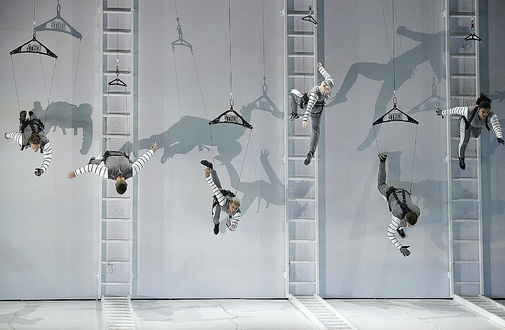Châtelet regains its 'luster'. Yes, its spider ('luster', in French) and the original light halo, then gas, today of LEDs. And the original stucco, and the four statues of the balcony and ... A restoration that has cost 32.3 million euros to the Paris City Hall led by Anne Hidalgo. Châtelet hopes to recover its luster, its brightness, its splendor. The inaugural, in imperial times of Napoleon III and Eugenia de Montijo. And the. avant-garde, in 1917 with the mythical Parade, of the father of Russian ballets, Diaghilev, who has inspired the reopening show.
Châtelet is the flagship of the cultural policy of the city council of Paris, with a vocation to influence the life of the capital. Christophe Girard, attached to the culture of Hidalgo, explained it to us in the hall of the local downtown a few days ago while the workers gave the last hammer blows.
He recalled that Jacques Chirac (mayor before being president) wanted to compete with the National Opera. They were times of avant-garde representations. A model that Alberto Ruiz Gallardón wanted for Madrid , first with the Theaters del Canal.
The Parisian cultural brand is intended as participatory, mestizo and modern. For that he has put his programming in the hands of Thomas Lauriot , whose last destination was the Monnaie in Brussels, and Ruth Mackenzie , who devised the cultural Olympiad of the London Games (2012) and was once an 'au pair' in Paris.
Just a moment. Today is April 19, 1862 and Empress Eugenia de Montijo inaugurates the Imperial Theater of the Châtelet that takes its name from a fortress that was in this same place, separated by the Seine from the Gothic building where María Antonieta was imprisoned.
Châtelet was born as a result of a political decision, that of the prefect (Civil Governor), Haussmann . The man who made modern Paris. For reasons of public order (wide streets that allow the passage of artillery), amid accusations of favoring friends and speculators, forcibly displacing many poor Parisians. Haussmann loaded seven theaters that hindered his urban design ...
In return he raised two. They survive. Today called the City Theater, closed for works until 2021 and for which the municipality has another 32 million, and Châtelet. Haussmann commissioned it from an architect friend, Gabriel Davioud. Then it had 2,895 seats, twice as much today ...
The ceiling was a stained glass window lit from above by gas lights. It stopped being used in 1890 when electricity and the large ceiling chandelier arrived. Now the glass ceiling surrounding the luster has been recovered. Illuminated with led bulbs, which will allow you to play with the intensity and color of the halo surrounding the glass lamp.
This and other details are told by the two architects in charge of the restoration, Philippe Pumain and Christian Laporte . Out asbestos and lead. Scenic box with the latest. The parquet, painting and wallpaper of the great foyer have recovered their original appearance. And, after removing 10 layers of overlapping paint, the stucco walls look like yesteryear.
The gloomy curtain and the colorful frescoes of the Chirac era survive. And the four statues, allegories of dance, drama, comedy and music) that disappeared at the end of the 19th century, have been redone and look at the square from the Nijinski terrace.
It is the fifth great restoration of Châtelet that has survived three great wars (the Franco-Prussian and the two world). He has seen Luis Mariano succeed, among others. And he has applauded 3,007 nights 'Around the world in 80 days'.
Here he premiered in 1917 'Parade' on the initiative of the father of the Russian Ballets, Serge Diaghilev with a dream art team: libretto by Jean Cocteau, music by Erik Satie, sets and costumes by Pablo Picasso and choreography by Léonide Massine.
The latter was also the first dancer of Russian ballets and Diaghilev's lover ... roles both in which he had replaced Vaclav Nijisnki . Diaghilev was the king of the show in St. Petersburg and after falling fascinated by the art of the young Nijinsky, he offered him a tour of Paris to sign him, which is why both lovers stormed Châtelet in 1909. For scandal (artistic and moral) of the Good society of the moment.
'Parade' (2017) wanted to embrace the spirit of his namesake a century earlier. Until the final wink: the bag given to each viewer of the premiere for picnics in the square had a muffin with white cheese and a coconut cake in reference to Satie, who only ate white foods (eggs, sugar, rice, turnips ...)
The orchestra opened the night with Satie's 'Mercury' but the strong point of the evening was put on stage, three acrobats? from Extreme Action , from New Yorker Elizabeth Streb. They turned six meters high suspended by the feet to the shaft. They looked like robots. First there were laughter and then stupefaction. The performance is called 'Pipe dreams' but it is known as 'the grinder'.
The circus on the reborn stage was completed, among other jovial numbers, with the funanbulist Tatiana Mosio Bongonga and some Russian bar acrobats. the show was preceded by a giant puppet parade from Mozambique accompanied by dozens of 'amateur' drums. Half a hundred actors, clowns, musicians and singers paid tribute to Satie in hallways, terraces and hallways of the hall.
Serve as a declaration of intent (fresh, informal, fun) for a program that Mackenzie wants "innovative, spectacular and participatory". Mestizo, feminine and avant-garde can be added.
In poster, the following is 'The Just' by Albert Camus, musical tragedy (rap and hip hop) with young amateurs from the (hard) neighborhood of Saint Denis. The thing promises. But not everything will be rupturist. For November 'An American in Paris' operetta of Gershwin is announced . No doubt. Châtelet wants to recover his luster of yesteryear.
According to the criteria of The Trust Project
Know more- culture
- theater

